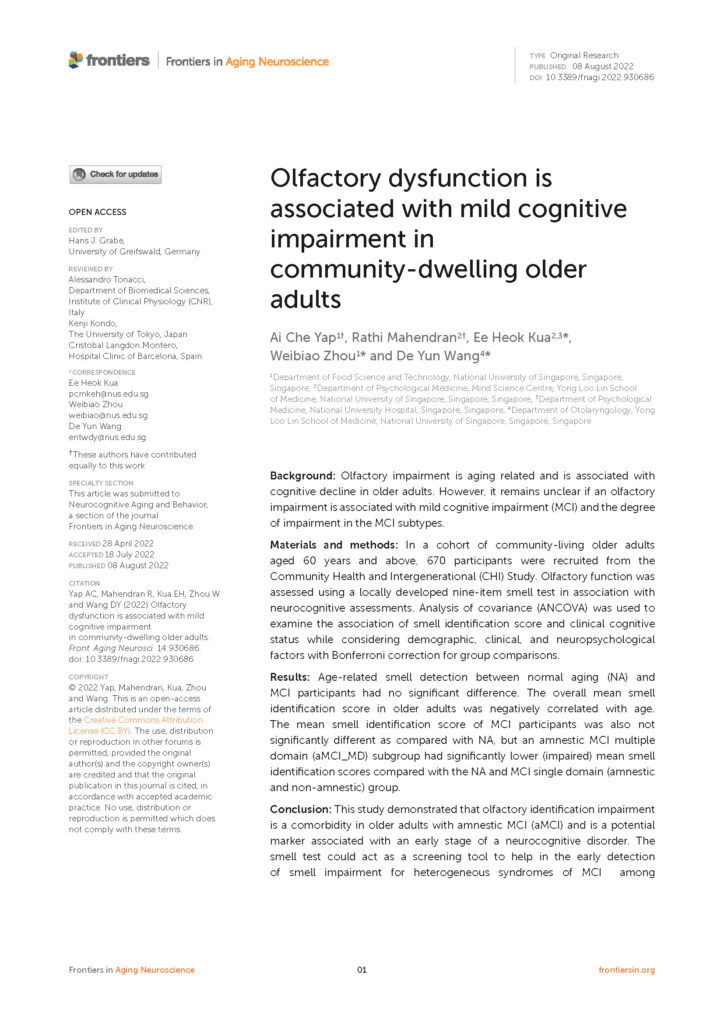Olfactory Dysfunction is Associated with Mild Cognitive Impairment (MCI)
This article is written based on the presentation done by Prof Wang De Yun at the NUS Psychiatry Symposium on Ageing-in-Place held on 27 Apr 2023.
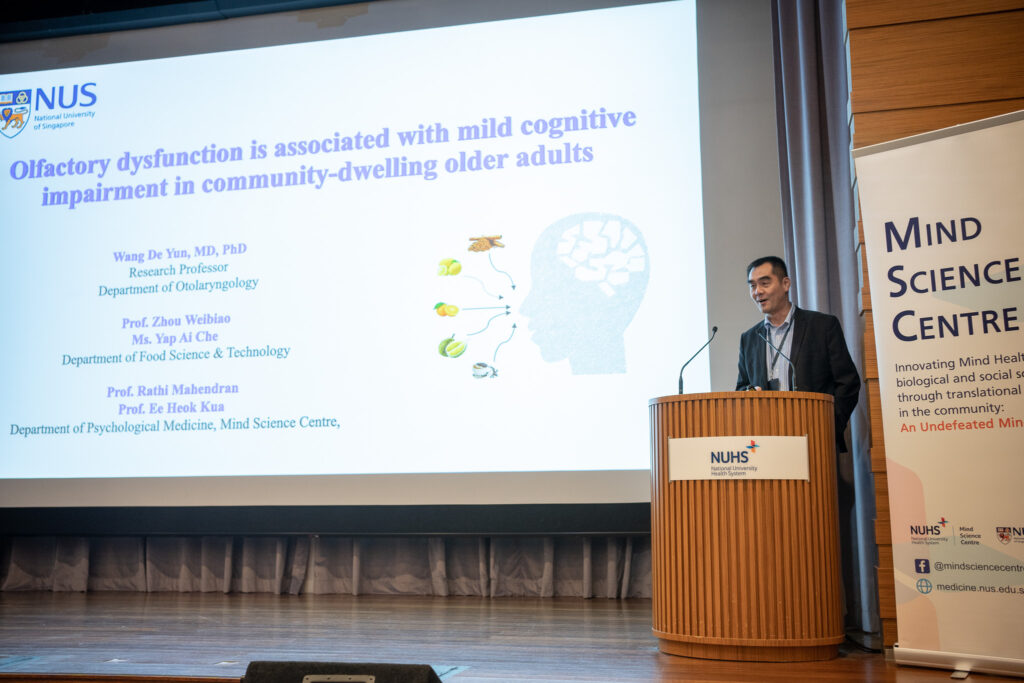
Olfactory impairment, or more commonly referred to as sense of smell, is ageing related. The ability to detect and identify smell has also long been linked with cognitive decline in older adults. However, there remains questions on its association with mild cognitive impairment (MCI) and by extension, dementia.
As part of the Yeo Boon Khim Mind Science Centre’s Community Health and Intergenerational (CHI) Study, Prof Wang De Yun from NUS Department of Otolaryngology, conducted a study to assess the olfactory function of community-dwelling older adults in Singapore and its link with their cognitive function. For this study, researchers at NUS developed a localised version of the nine-item smell test to better screen the population.
Read more below!
Smell ability as a predictive tool for Cognitive Impairment
When it comes to modifiable risks of dementia, the focus is often on vision and hearing impairments rather than smell impairment. Nonetheless, there are studies indicating a potential link between smell identification ability and MCI.
A meta-analysis found that smell identification is impaired in those with MCI compared with healthy older adults. Longitudinal studies also showed that cognitively healthy individuals with smell impairments at baseline subsequently developed MCI in the follow-up.
The evidence suggests that smell identification has the potential to detect and predict the risks of developing dementia in later life.
To the best of our knowledge, there has yet to be any study examining smell function in Singapore’s healthy and/or cognitively impaired community-dwelling older adult population. Mind Science Centre’s study aimed to assess their smell identification ability and associate the outcomes with their cognitive status.
Culture specific smell test developed in NUS
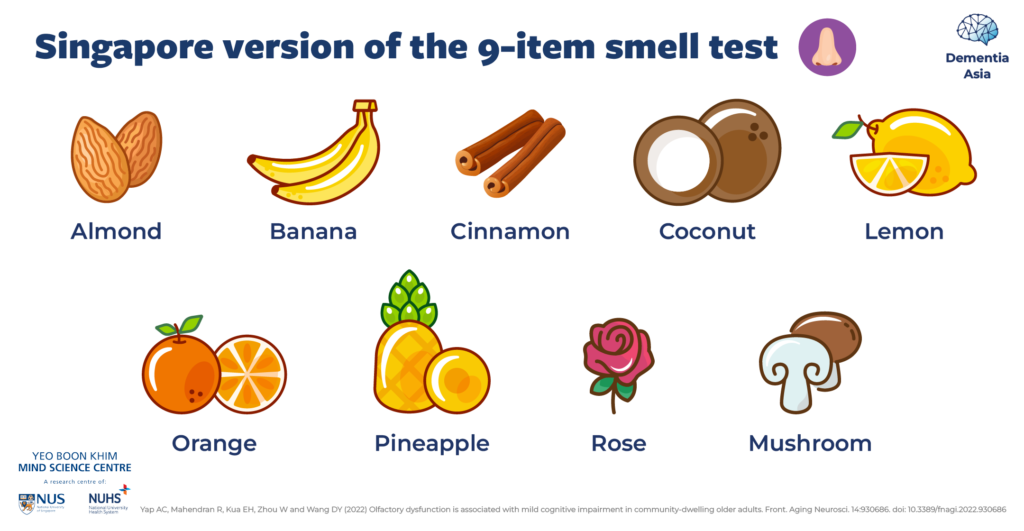
The original nine-item smell test developed by the University of Pennsylvania (UPSIT) included items as liquorice, dill pickle, and skunk. These are not common in Singapore and participants often struggle to recognise and identify them.
To better screen and evaluate smell function in Singapore’s older adult population, our researchers recognised a need to create a localised version of the smell test that is culture-specific to our population. Researchers in NUS developed the Singapore version of the 9-items Smell Test Panel based on a local smell familiarity survey. This includes almond, banana, cinnamon, coconut, lemon, orange, pineapple, rose, and mushroom.
Beyond this study, other clinicians and researchers could also benefit from this locally developed smell test to better screen their patients or research participants.
Study Design
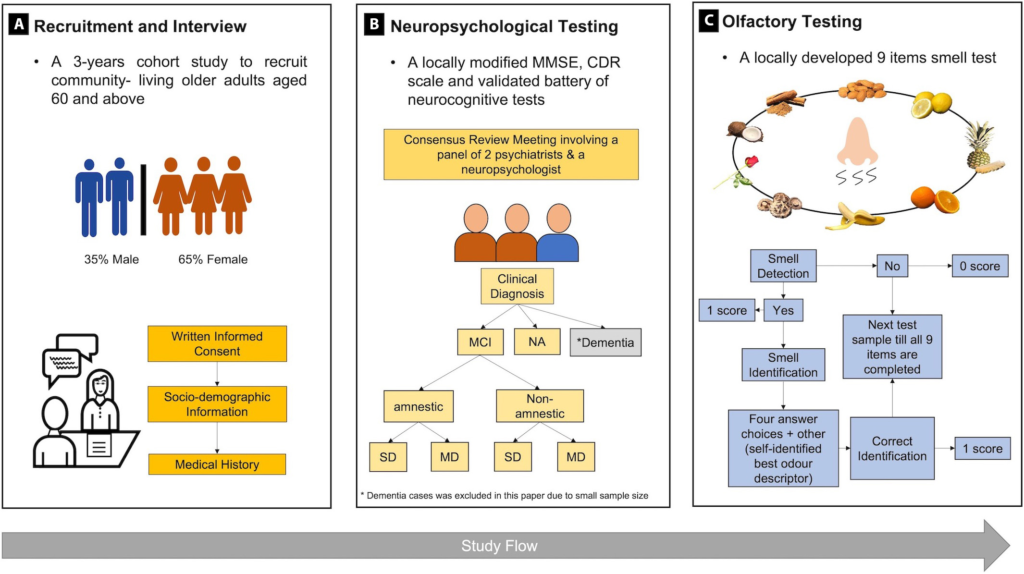
Participants aged 60 years and above were recruited from a larger epidemiological study titled Community Health and Intergenerational (CHI) study. The smell test and neuropsychological testing are part of a 10-hour assessment done over five separate visits. More details on that can be found in the CHI study protocol.
Smell Tests For Cognitive Impairment
The locally developed nine-item smell test was used to assess smell detection and identification. The test was conducted in an interview format with each odour sample (in total 9) given only once. Between each odour, there was at least a 30-second time interval to prevent sensory fatigue.


For the smell detection task, participants were asked to respond yes or no based on their perception of the presence of an odour. Each successful detection was scored a point.
For the smell identification task, participants were asked to identify the same test odour before choosing through 4 narrated answer choices. If they thought none of the answer choices matched the test odour, they were allowed to describe the odour instead. Each successful identification was scored a point.
Cognitive Function Tests - Testing for Cognitive Impairment
Participants’ cognition was measured with the modified mini-mental state examination (MMSE) scale, clinical dementia rating (CDR) scale, and a validated battery of neurocognitive tests. The protocol is described in more details here.
Diagnosis of the participants’ cognitive status was made at consensus review meetings involving two psychiatrists and a neuropsychologist. Participants were categorised into normal ageing, MCI, or dementia and further subtyped as amnestic or non-amnestic, and single or multiple domain.
- NA (normal ageing)
- naMCI_SD (non-amnestic mild cognitive impairment, single domain)
- naMCI_MD (non-amnestic mild cognitive impairment, multiple domains)
- aMCI_SD (amnestic mild cognitive impairment, single domain)
- aMCI_MD (amnestic mild cognitive impairment, multiple domains)
- Dementia
Smell test results in Singapore community-dwelling older adults
A total of 670 participants completed the smell test. 527 (78.8%) of the cohort were categorised under normal ageing and 143 subjects (21.3%) had MCI.

Smell detection is significantly lower in the above 80 age group
The smell detection score 0-9 was calculated by the number of detected scents out of the 9 test odours.
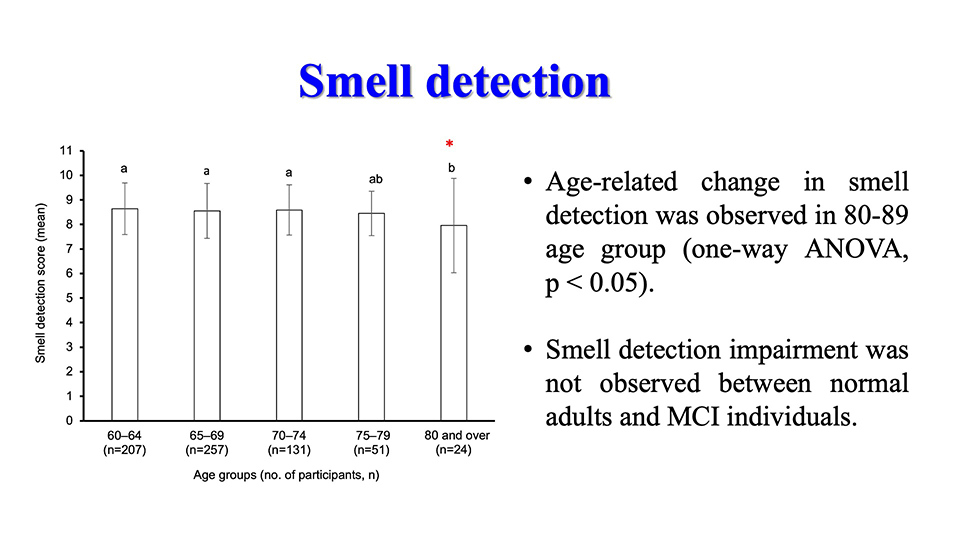
The study found significant age-related changes in smell detection in the 80-89 age group as compared to the younger age groups. No significant differences in smell detection score were found between the different cognitive states (normal ageing and MCI).
Smell identification scores tend to decrease with age
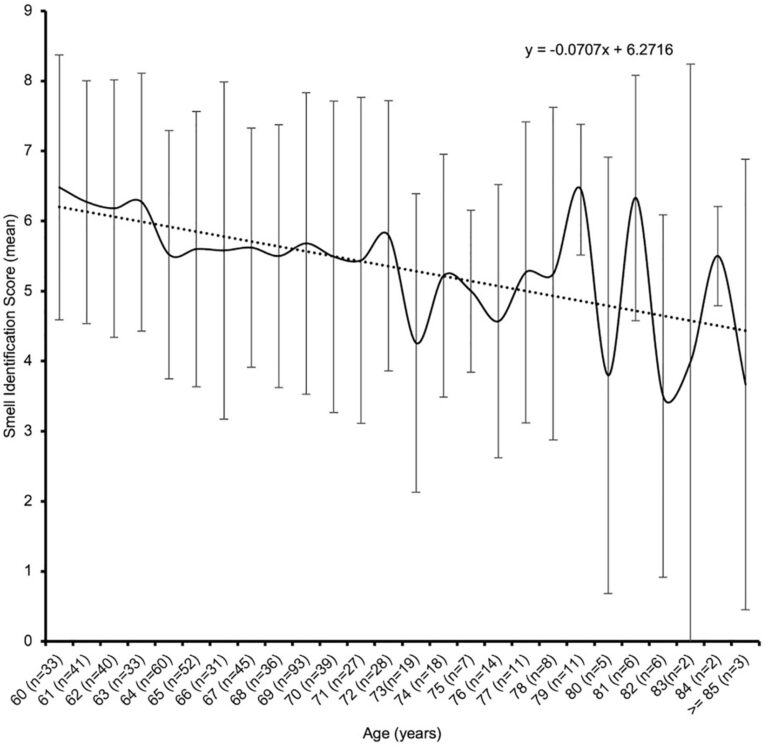
The smell identification score 0-9 was calculated as the total score of correct identification.
Results showed that there is a slow and progressive decrease in the smell identification scores from 60 to 80 years and above. Through Pearson’s correlation coefficient analysis, smell identification score was weakly and inversely correlated with age (r = -0.18, p < 0.01).
Gender differences in smell identification
Females had significantly higher scores than males in the smell identification test.
During his lecture at the NUS Psychiatry Symposium on Ageing in Place, Prof Wang De Yun suggested that a potential cause of this difference is traditional gender roles. Especially in the cohort of older adults, females were more likely to spend time cooking and preparing food.
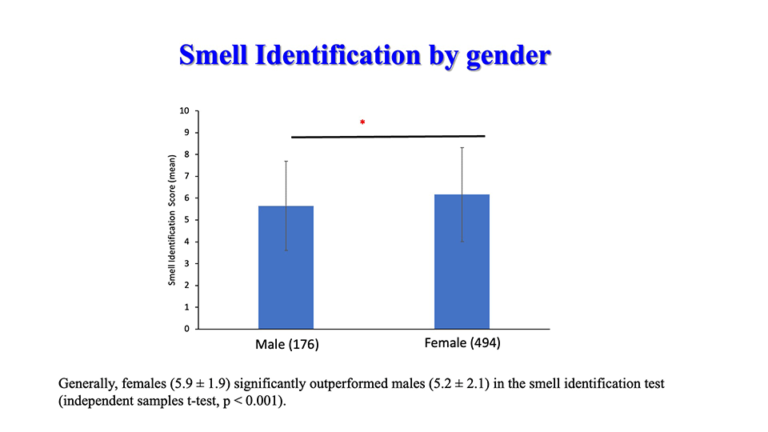
Smell identification scores in those with mild cognitive impairment (MCI)
In comparing the smell identification scores of those in the normal ageing group and those with MCI, findings revealed that those with MCI had slightly lower scores, although the difference did not reach statistical significance.
However, on analysis of each MCI sub-group, individuals with amnestic MCI with multiple domains (aMCI_MD) exhibited significantly lower smell identification scores compared to those in the normal ageing group.
Takeaway message: olfactory impairment is a potential screening marker for cognitive decline
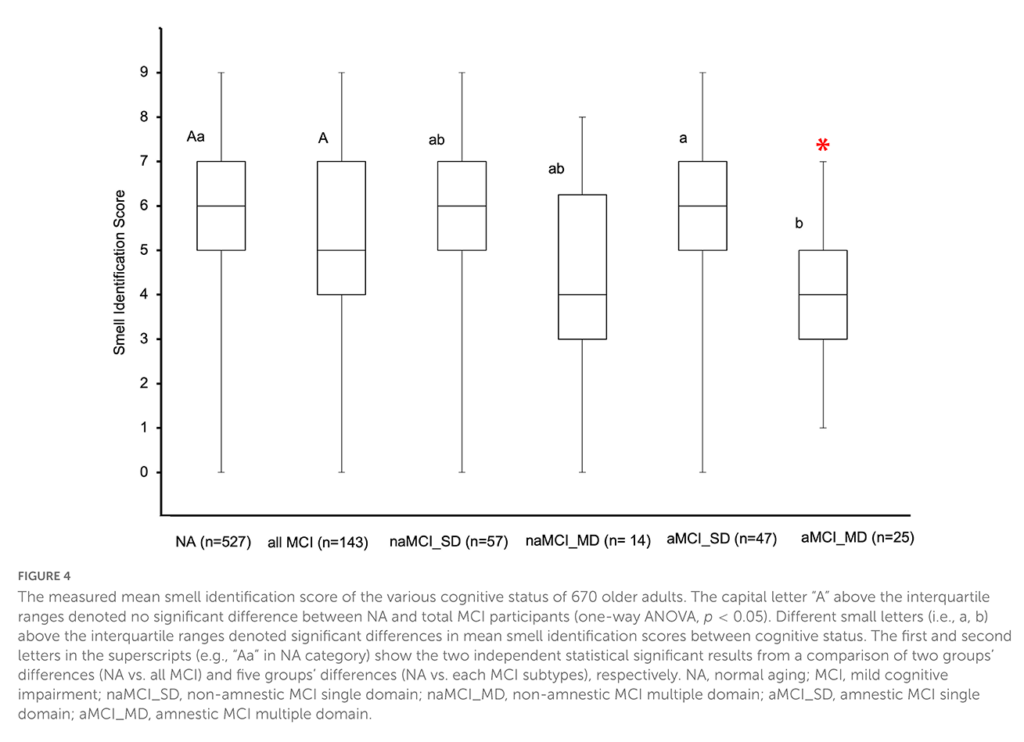
Despite the limited sample size, the study findings show that there is indeed a decline in olfactory function in those with MCI, especially those in the aMCI_MD group. Considering the overall differences in smell ability between those who had cognitive scores in the normal range and those in the MCI group, it is possible that olfactory impairment might be a potential baseline risk factor to predict progression to dementia in later life.
Take charge of your ageing with community-based activities!
Along with the ageing population, the rate of dementia has been on the rise. Most dementia cases do not develop overnight, rather it is a gradual decline in cognitive function.
Mild cognitive impairment (MCI) is a pre-dementia stage between normal ageing and dementia. While there is currently no cure for dementia, it is possible to slow or reverse MCI through cognitive stimulating activities.
Click to find out more about our Age Well Everyday programme!
Yap AC, Mahendran R, Kua EH, Zhou W and Wang DY (2022) Olfactory dysfunction is associated with mild cognitive impairment in community-dwelling older adults. Front. Aging Neurosci. 14:930686. doi: 10.3389/fnagi.2022.930686
Wang, DY (2023, Apr 27). Olfactory dysfunction is associated with mild cognitive impairment in community-dwelling older adults. In NUS Psychiatry Symposium on Ageing-in-Place, April 27, 2023.
Follow us on Facebook for more free mental health resources!
Health and Nutrition: The Mushroom Connection
A recent review by Professor Barry Halliwell and Dr Irwin Cheah explored the diet-derived compound ergothioneine (ET), commonly found in...
Find Out MorePsychological First Aid – Brief Integrative Psychological Therapy (BIPT) Training for Community Volunteers
A paper published by Mind Science Centre found that community-based activities including tai chi, mindfulness practice, art therapy, and music...
Find Out MoreDifferent Speech Patterns in Those With and Without Amnestic Dementia
A paper published by Mind Science Centre found that community-based activities including tai chi, mindfulness practice, art therapy, and music...
Find Out MoreThe Rising Number of Dementia Cases in Singapore and Asia
A paper published by Mind Science Centre found that community-based activities including tai chi, mindfulness practice, art therapy, and music...
Find Out MoreImproving Sleep Quality in Older Adults with Non-drug Approaches
A paper published by Mind Science Centre found that community-based activities including tai chi, mindfulness practice, art therapy, and music...
Find Out More
